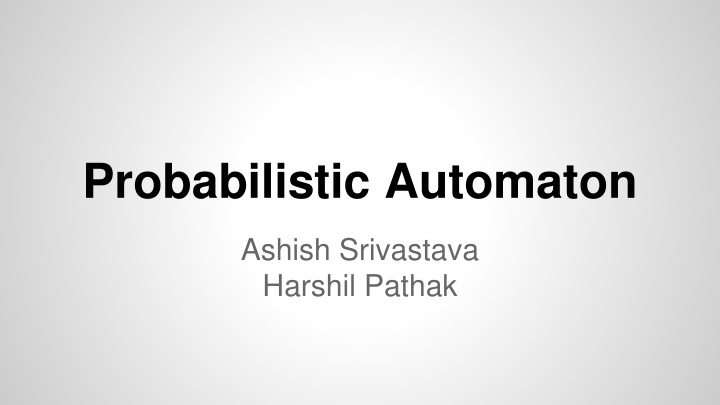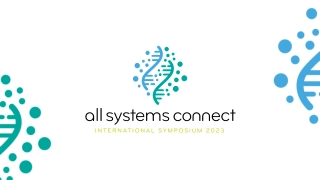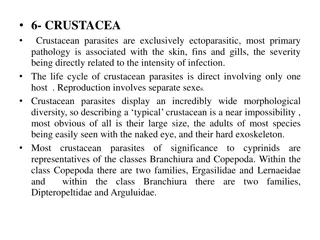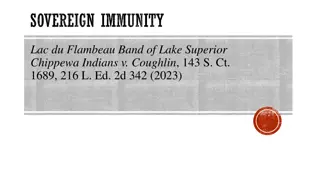
Probabilistic Automaton and Its Applications
Explore the concept of probabilistic automaton, its extensions, and how it is utilized in modeling asynchronous systems, communication protocols, and more. Learn about stochastic languages, distributions over strings, and the practical uses of probabilistic automata.
Download Presentation

Please find below an Image/Link to download the presentation.
The content on the website is provided AS IS for your information and personal use only. It may not be sold, licensed, or shared on other websites without obtaining consent from the author. If you encounter any issues during the download, it is possible that the publisher has removed the file from their server.
You are allowed to download the files provided on this website for personal or commercial use, subject to the condition that they are used lawfully. All files are the property of their respective owners.
The content on the website is provided AS IS for your information and personal use only. It may not be sold, licensed, or shared on other websites without obtaining consent from the author.
E N D
Presentation Transcript
Probabilistic Automaton Ashish Srivastava Harshil Pathak
Outline Introduction to Probabilistic Automaton Deterministic Probabilistic Finite Automata Probabilistic Finite Automaton Probably Approximately Correct (PAC) learnability
Motivation Serves the purpose of modeling and analyzing asynchronous, concurrent systems with discrete probabilistic choice in a formal and precise way randomized, distributed algorithms probabilistic communication protocols the Binary Exponential Back Off protocol fault tolerant systems speech recognition
Probabilistic Automaton It s an extension (generalization) of Finite Automata. It includes the probability of a transition into the transition function. Languages recognised by probabilistic automaton are called stochastic languages.
Definition Finite set of states Q finite set of input symbols a transition function :Q x -> 2Q transition probabilities P: Q x x Q -> [0,1] final-state probabilities F: Q -> [0,1] Stochastic Matrix P gives the probability of transition from one state to another taking a particular symbol. q Q, F(q) + a,qp(q,a,q ) = 1
Distributions over strings Given a finite alphabet , the set * of all strings over is enumerable and therefore a distribution can be defined. A probabilistic language D is a probability distribution over * . The probability of a string x * under the distribution D is denoted by a non-negative value PrD(x) and these probabilities must add to one.
Usefulness They do not tell us if a string belongs to a language. They are good candidates for grammar induction e.g. Having seen so far abbaba , what is the next symbol This distribution, if learnt from data, can in turn be used to disambiguate, by finding the most probable string corresponding to a pattern, or to predict by proposing the next symbol for a given prefix, when the structure of the automaton is unknown. If the structure is known, the problem becomes probability estimation problem.
Probability of string aba in given PFA Pr(aba) = 0.7*0.4*0.1*1 + 0.7*0.4*0.35*0.2 = 0.028 + 0.0252 = 0.0532
DPFA Even though determinism restricts the class of distributions that can be generated, we introduce deterministic probabilistic finite-state automata because of the following reasons: Parsing is easier as only one path has to be followed. Some intractable problems (finding the most probable string, comparing two distributions) become tractable. There are a number of positive learning results for DPFA that do not hold for PFA .
Computing Probabilities The computation of the probability of a string is by dynamic programming : O(n2m) Backward and Forward algorithm (popularly used in Hidden Markov Models) If we want the most probable derivation to define the probability of a string, then we can use the Viterbi algorithm
Learning Paradigm for DPFA Given a class of stochastic languages or distributions C over *, an algorithm A Probably Approximately Correctly (PAC) learns C if there is a polynomial q such that for all c in C, all ? > 0 and > 0, A is given a sample Snand produces a hypothesis Gn, such that Pr[D(c||Gn) > ?] < , whenever m > q(1/?,1/ , |c|), where |c| is some measure of the complexity of the target. We say is the confidence parameter and ? is the error parameter.
Distance measure Two distributions over * : D and D Kullback Leibler divergence (or relative entropy) between D and D : w * PrD(W) * [log (PrD(w) / PrD (w))]
References 1. Clark, Alexander, and Franck Thollard. "PAC-learnability of probabilistic deterministic finite state automata." The Journal of Machine Learning Research 5 (2004): 473-497. 2. De la Higuera, Colin. Grammatical inference: learning automata and grammars. Cambridge University Press, 2010. 3. Probabilistic Finite State Machines. Franck Thollard. 4. Stoelinga, Mari lle. "An introduction to probabilistic automata." Bulletin of the EATCS 78.176-198 (2002): 2. 5. Vidal, Enrique, et al. "Probabilistic finite-state machines-part I." Pattern Analysis and Machine Intelligence, IEEE Transactions on 27.7 (2005): 1013-1025.


















